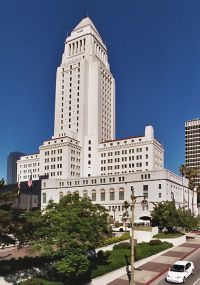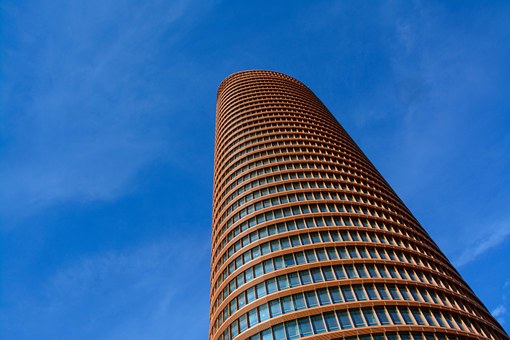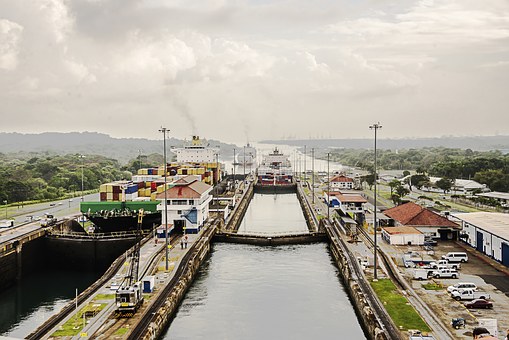Andrew Jacobs studied Building Science Civil Engineering at USC in the fall of 2004. His main academic interests include creative civil engineering design and architecture. He transferred to USC in fall 2002 from Westmont College in Santa Barbara to complete a dual degree program.
Base isolation has become a major feature of structural design in the past few decades. While a relatively simple concept, base isolation has a long and involved history of engineering influence and will take many more years to refine. Base isolators act on well-understood physical principles such as energy, oscillation, and damping. Rubber bearing base isolators, which are commonly used in modern buildings, owe much of their development to the work of James M. Kelly at the University of California at Berkeley, among others.
Introduction
There are currently hundreds of buildings worldwide that are held up by rubber—that is, they are not rigidly fixed to the foundations on which they rest. It may come as a surprise that these rubber foundation elements can actually help minimize earthquake damage to buildings, considering the tremendous forces these buildings must endure in a major quake. For nearly four decades, seismic analysis engineers have been perfecting unusual and complex systems called base isolators to protect buildings from earthquakes [1]. These devices are currently protecting thousands of people worldwide (see Fig. 1), but many in the general public know little about them and the history of earthquake protection design. To catch a glimpse into the world of modern seismology and the work of seismic engineers like James M. Kelly, we will focus our attention on the engineering behind a specific kind of base isolator: the rubber bearing.
Seismic Intuition
Most of us think that a stronger, more rigid attachment of a building to its foundation will result in less damage in an earthquake. Our intuition tells us: “strengthen to resist damage.” The problem with this idea is that if the foundation is rigidly attached to the superstructure, all of the force of the earthquake will be transferred directly and without a change in frequency to the rest of the building [2]. Earthquakes shake the base of buildings laterally, applying what is called shear force to the foundation [3]. When such a large force occurs at the building’s natural frequency, the building will fail and possibly collapse. Fig. 2 demonstrates the seismic loading response difference between stiffer and less rigid structures.
Engineers know the importance of keeping the superstructure stable while the foundation is being shaken by an earthquake. However, designing a system that puts this concept into practice presents significant challenges. How can a superstructure not rigidly attached to the foundation be guaranteed to stay in place during an earthquake? The first attempts at solving this structural difficulty were made around the turn of the 20th century, but proposed designs did not become practical to build until a few decades ago [3]. In 1967, three engineers working at the Physics and Engineering Laboratory of the Department of Scientific and Industrial Research (PEL, DSIR) in New Zealand began significant research on and development of seismic isolation devices [1]. R. Ivan Skinner and his associates, along with many other engineers doing independent work in other countries, have produced a wealth of information about base isolators and seismic control. Since their initial efforts, base isolators have become common knowledge to civil and structural engineers.
The Ultimate Shock Absorber
Rubber bands and the shock absorbers in cars have a lot in common. They both allow stretching, but as they stretch they increasingly resist further stretching. When the stretching force is released, they return to their natural length. Engineers wanted to use a similar system to protect buildings from earthquakes. But unlike shock absorbers, which provide vertical isolation from road bumps, the vibration control needed for buildings is lateral, because the most destructive seismic motions for buildings are lateral [3]. Since base isolators must support the full weight of the building, they must be extremely strong [4]. This level of strength can be achieved using a laminated rubber bearing (LRB). This rubber and steel device is able to resist the weight of a structure while simultaneously allowing the foundation to move with the ground during an earthquake and isolating the superstructure from the harsh acceleration, frequency and energy of the earthquake [3].
A laminated rubber bearing consists of thin steel plates (about 3 millimeters in thickness) and an elastomer thicker than the steel [5] in alternating layers bonded together as well as thick steel top and bottom plates [4]. The manufacture of LRBs involves a vulcanization bonding procedure, which is a series of thermal and chemical processes that affix and harden the liquid rubber in between the steel plates.
While a range of sizes can be achieved, a typical LRB is between a cubic foot and a cubic yard in volume and can weigh a ton or more [4,6]. The interior steel plates keep the elastomer from spreading out very far horizontally by holding each elastomer layer’s top and bottom in place [4]. This results in a vertical resistance to the weight of buildings that may be hundreds of times greater than the horizontal resistance to seismic motion.
It is worth noting that other solutions to the problem of isolating superstructures–such as the friction pendulum system (FPS) and other friction base isolation devices–have been explored and produced as well [2]. While these are not discussed here, the interested reader can visit the “Further Exploration” section at the end of this article for more information.
The Physics of LRB
Earthquakes produce enormous seismic vibrations that travel through bedrock [7]. As the energy of the earthquake travels in waves through the ground, certain frequencies of vibration retain more energy than others depending on the mechanical properties of the surrounding soil [6]. Every building has a fundamental frequency (usually between 5 and 0.833 Hertz) that often falls within the range of seismic frequencies [4]. The fundamental frequency depends on many factors, including the stiffness of the structure and the height of the building [6]. Engineers can calculate the fundamental frequency of a building before it is built using computer software; however, most designs stay within a fairly narrow range.
As an earthquake shakes the soil laterally, the foundation moves with the soil and the seismic waves are transferred throughout the structure over time as the seismic wave travels up the structure. If the earthquake has natural frequencies with high energy that match the natural frequencies of the building, it will cause the building to oscillate violently in harmony with the earthquake frequency . The energy the earthquake loses as it moves a structure is proportional to the stiffness of the structure. Thus, in a non-isolated state, the building itself becomes an outlet for the energy of the earthquake because in all of its structural components it has to provide tremendous resistance (force) to the seismic motion [4,6].
However, if the natural frequency of the building can be changed to a frequency that does not coincide with that of earthquakes, the building is less likely to fail [3]. This is exactly what a base isolator does. The base isolator reduces the stiffness of the structure and thereby lowers its natural frequency. In this condition, the building’s superstructure will respond to the vibrations as a rigid unit instead of resonating with the vibrations . Simply put, the building’s foundation moves with the ground and the base isolator flexes to reduce the ground motion from affecting the superstructure [3].
A Real Shaker
One of the most influential seismologists of our time is James M. Kelly, a professor at the University of California at Berkeley. He has been researching base isolation for nearly three decades and has made significant contributions to the field through extensive testing of various types of devices and through analytical modeling concepts [8]. His work with the Earthquake Engineering Research Center (EERC) at Berkeley began in association with the Malaysian Rubber Producers Research Association (MRPRA), U.K, which provided the initial funding [3]. The National Science Foundation (NSF) played a key financial role starting in the late 1970s [8]. This research funding marked the beginning point for bringing base isolation into practice domestically. By 1985, Kelly’s work came to fruition when the first major building project to incorporate base isolation—the Foothill Communities Law and Justice Center in San Bernardino County—was completed [8].
Beginning in the early 1990s, Kelly directed his research towards cheaper and lighter base isolation systems for use in developing countries [5]. The United Nations Industrial Development Organization (UNIDO) has funded this research and implementation effort. One main strategy in creating cheaper, lighter bearings is to reduce the thickness of the steel plates. The engineers working on the project realized that for lighter-weight buildings, designs using the standard elastomer were structurally problematic because the rubber bearings would be too tall, resulting in poor vertical balancing of the superstructure . MRPRA was able to solve this problem for Kelly by changing the chemical makeup of the rubber by adding a substance called carbon black. This change in elastomers resulted in a new kind of base isolators, high density natural rubber bearings (HDNR), which were more suitable for lighter, cheaper buildings—just as Kelly was hoping. Kelly’s work progressed over the years and he is held in high regard among seismic and structural engineers for his work [3, 8].
Damping
While a simple base isolator is effective at protecting buildings from seismic movements, it cannot necessarily dissipate the energy that it obtains during an earthquake [3]. As a result, although the building is unlikely to collapse, it may continue oscillating after an earthquake as the energy that was imparted to it through the base isolators is finally dissipated [3]. Seismic engineers realized that a damping system must be used in conjunction with isolators in order to deplete energy [4]; keep the center of gravity of the building over the center of the foundation [9]; and bring the building back to center quickly after the seismic vibrations [10]. Dampers deplete the energy that would normally keep a building oscillating side to side by applying a restoring force to bring the superstructure and foundation into alignment. Because a force acting over a distance creates work, the energy in the system is expelled through the work of the damper [4].
While there are four types of dampers–passive, semi-active, active, and hybridwe will focus on passive and semi-active dampers, the most prevalent and the most innovative, respectively [11]. Passive techniques require no outside energy to be able to control and dampen the movements of the isolator. Lead has been used as a passive damper, which is installed vertically through the center of LRBs [10]. This composite system is known as a lead-core rubber bearing (LCRB). Although the lead increases the natural frequencies of the building, it does not bring it back into the range of earthquake frequencies. Not only does the stiff but malleable lead core help dampen the system during seismic activity, it also maintains the stiffness of the system under wind forces [10]. Another kind of passive damper that has gained widespread approval and use is the high damping rubber bearing (HDRB), which uses a particular kind of elastomer [3]. Both LCRBs and HDRBs exhibit non-linear damping [1]. In other words, when a building superstructure is displaced during an earthquake, the damping does not increase proportional to the distance of displacement. Significant research on the part of engineers goes into theoretical and mathematical modeling of such non-linear systems [12].
Semi-active dampers have been a hot topic in the last few years [11]. B.F. Spencer of the University of Notre Dame has been working on developing “smart” isolators that ascertain the response of a building to seismic vibrations and then apply external force damping to most effectively return the building to its normal state [13]. “Fuzzy controllers” have surfaced as another topic of research that focuses on a variation of artificial intelligence that knows or learns over time how a building will respond to seismic forces and dampens accordingly [11]. As this research in semi-active dampers continues, more and more effective solutions to the problem of building stability are coming to light. Over time, the catastrophic failure of buildings may become a rare event as more and more buildings are retrofitted and the technology to protect them using computer intelligence improves.
Conclusion
Base isolation has developed into a deep field requiring the work of many engineers and affecting the lives of people across the world, whether they are aware of it or not. By observing and analyzing the physical phenomena that cause buildings to crumble, engineers have devised an effective strategy to sidestep this problem. Rubber, steel and damping systems combine to turn otherwise dangerous earthquakes into minor threats. Through the use of base isolation, buildings such as the USC University Hospital have withstood earthquakes even as severe as the Northridge earthquake (NISEE). As the years go by and more earthquakes hit, this twentieth-century breakthrough in structural design may prove to be a life-saving innovation of historic proportions.
References
-
- [1] R. Skinner, W. Robinson, and G. McVerry. Seismic Isolation. Chichester, England: John Wiley & Sons, 1993.
- [2] J. Fan and J. Tang. “Dynamic Analysis for Structures Supported on Slide-limited Friction Base Isolation System,” in Earthquake Engineering Frontiers in the New Milennium, pp. 329-337. B.F. Spencer and Y.S. Hu, ed. Lisse, Netherlands: A.A. Balkema, 2001.
- [3] J. Kelly. “Base Isolation: Origins and Development.” National Information Service for Earthquake Engineering (NISEE). Internet: http://nisee.berkeley.edu/lessons/kelly.html, Oct. 28, 1998 [Mar. 25, 2004].
- [4] J. Sackman, J. Kelly, and A. Javid. Energy Research, Inc. Internet: http://www.xi1.com/baseisolation/index.html, 1999 [Mar. 25, 2004].
- [5] W. Taniwangsa, P. Clark, and J.M. Kelly. “Natural Rubber Isolation Systems for Earthquake Protection of Low-Cost Buildings.” Berkeley: EERC, Jun. 1996.
- [6] F. Zhou and Q. Xian. “Recent Development on Seismic Isolation, Energy Dissipation, Passive and Semi-active Control of Structures in P.R. China,” in Earthquake Engineering Frontiers in the New Millennium, pp. 279-285. B.F. Spencer and Y.S. Hu, ed. Lisse, Netherlands: A.A. Balkema, 2001.
- [7] B. Spencer, H. Yoshioka, J.C. Ramallo, and E.A. Johnson. “‘Smart’ Base Isolation Systems: Theory and Experiment” in Earthquake Engineering Frontiers in the New Millennium, pp. 259-265. B.F. Spencer and Y.S. Hu, ed. Lisse, Netherlands: A.A. Balkema, 2001.
- [8] J. Kelly. “Base Isolation in Japan, 1998.” Berkeley: EERC, December 1988.
- [9] M. Fragiacomo, S. Rajgelj, and F. Cimadom. “Design of Bilinear Hysteretic Isolation Systems.” Earthquake Engineering and Structural Dynamics (EESD), vol. 32, pp. 1333-1352. New York: John Wiley & Sons, Jul. 2003.
- [10] B. Samali, Y.M. Wu, and J. Li. “Shake Table Tests on a Mass Eccentric Model with Base Isolation.” EESD, vol. 32, pp. 1353-1372, Jul. 2003.
- [11] L. Zhou, C.C. Chang, and L. Wang. “Adaptive Fuzzy Control for Nonlinear Building—Magnetorheological Damper System.” Journal of Structural Engineering, vol.129, iss.7, pp. 905-9, Jul. 2003.
- [12] Tsai, C.S; Chiang, Tsu-Cheng; Chen, Bo-Jen; and Lin, Shih-Bin. “An Advanced Analytical Model for High Damping Rubber Bearings.” EESD, vol. 32, pp 1373-1387, Jul. 2003.
- [13] J. M. Kelly; I. Buckle, and C.G. Koh. “Mechanical Characteristics of Base Isolation Bearings for a Bridge Deck Model Test.” Berkeley: Earthquake Engineering Research Center (EERC), Nov. 1987.
- [14] E. Johnson. Interview. Apr. 20, 2004.




